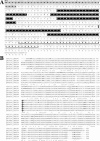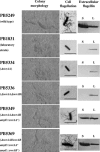Swarming differentiation and swimming motility in Bacillus subtilis are controlled by swrA, a newly identified dicistronic operon
- PMID: 16030230
- PMCID: PMC1196031
- DOI: 10.1128/JB.187.15.5356-5366.2005
Swarming differentiation and swimming motility in Bacillus subtilis are controlled by swrA, a newly identified dicistronic operon
Abstract
The number and disposition of flagella harbored by eubacteria are regulated by a specific trait successfully maintained over generations. The genes governing the number of flagella in Bacillus subtilis have never been identified, although the ifm locus has long been recognized to influence the motility phenotype of this microorganism. The characterization of a spontaneous ifm mutant of B. subtilis, displaying diverse degrees of cell flagellation in both liquid and solid media, raised the question of how the ifm locus governs the number and assembly of functional flagella. The major finding of this investigation is the characterization of a newly identified dicistronic operon, named swrA, that controls both swimming motility and swarming differentiation in B. subtilis. Functional analysis of the swrA operon allowed swrAA (previously named swrA [D. B. Kearns, F. Chu, R. Rudner, and R. Losick, Mol. Microbiol. 52:357-369, 2004]) to be the first gene identified in B. subtilis that controls the number of flagella in liquid environments and the assembly of flagella in response to cell contact with solid surfaces. Evidence is given that the second gene of the operon, swrAB, is essential for enabling the surface-adhering cells to undergo swarming differentiation. Preliminary data point to a molecular interaction between the two gene products.
Figures






References
-
- Allison, C., and C. Hughes. 1991. Bacterial swarming: an example of prokaryotic differentiation and multicellular behaviour. Sci. Prog. 75:403-422. - PubMed
-
- Chen, J. C., P. H. Viollier, and L. Shapiro. 2005. A membrane metalloprotease participates in the sequential degradation of a Caulobacter polarity determinant. Mol. Microbiol. 55:1085-1103. - PubMed
-
- Dong, T. C., and S. M. Cutting. 2003. SpoIVB-mediated cleavage of SpoIVFA could provide the intercellular signal to activate processing of pro σK in Bacillus subtilis. Mol. Microbiol. 49:1425-1443. - PubMed
Publication types
MeSH terms
Substances
LinkOut - more resources
Full Text Sources
Other Literature Sources
Molecular Biology Databases

